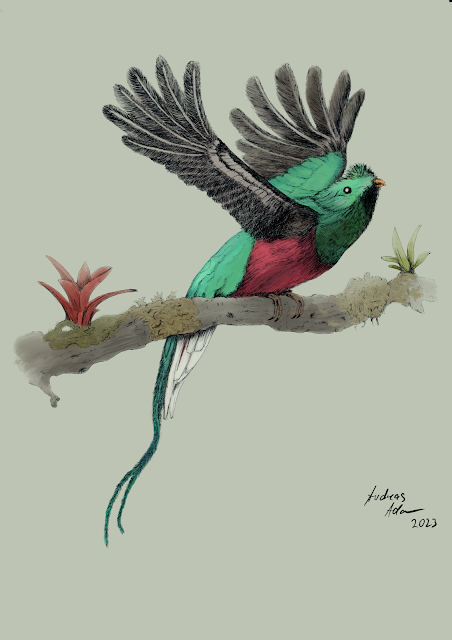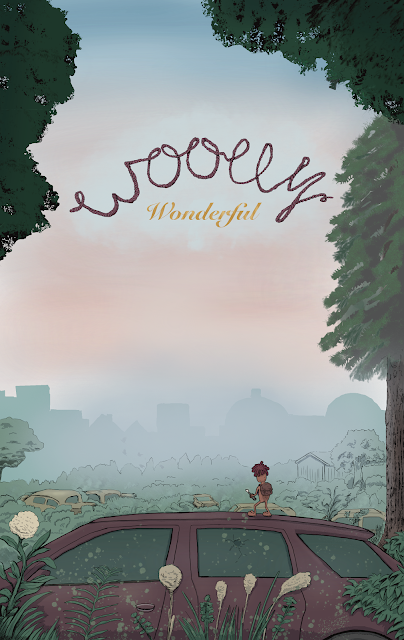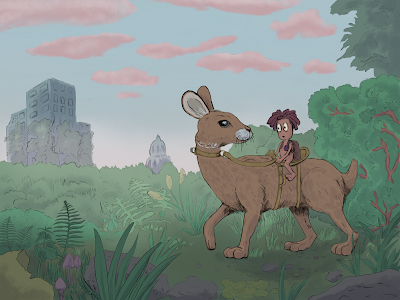Quetzal - The God of Birds - Illustration
I recently finished a longer project that I started as part of a Domestika course. The style of that particular course gathered my interest, because it reminded me of older illustrations in animal books or natural history books.
As tools only a ballpoint pen was used, except from sketching in pencil. That meant all the textures were done with a huge and varying amount of strokes. The course teaches you how to achieve different textures. And also, don’t be afraid to make mistakes, they will happen.
This is the resulting image:
The animal of choice
This is the Resplendent Quetzal, one of the 6 subspecies of Quetzal. They all live in the area of Middle and South America, in higher altitudes that feature foggy rain forests. - They can live up to 20 - 25 years
- They are omnivorous, eating insects, lizards, grubs, and mostly fruits
- The male has a yellow beak, the female has a black beak
- The male only grows the distinct long tail feathers during mating season
- The male also has the brighter, more distinct colours, whereas the female is more brownish
- Most birds have 3 toes pointing forward and one pointing backwards. The quetzal has two toes pointing backwards which gives it a weak grip
- The Mayas and Aztecs worshipped this bird and used its feathers as traditional jewellery, but the bird itself was not killed.
- Compared to today, the bird is threatened by deforestation and habitat loss. It is even threatened by international pet trade. Fortunately, the IUCN status is still at near threatened, though population numbers are going down
- Ironically the plumage is very delicate, so the feathers start falling out very easily, especially under wrong keeping conditions. This also creates challenges for preserving stuffed birds in museums as the colours easily fade away
- In some countries, the bird is a vital symbol in the human culture, e.g. it is part of the national flag of Guatemala. Even their currency is called quetzal.
So how was the above image created?
2. Thumbnailing the scene. Thumbnailing means to create little sketches where you explore ideas and composition. I don’t need to draw nicely to produce a neat image at this stage, it’s rather about finding the most pleasing composition. The are some well established composition rules for hundreds of years around, you might want to check the internet for them. Here are some of my thumbnails:
3. Once that was finished, I needed to prepare a posture sketch. There are two options on how to do it:
First option, you create a rough sketch of your subject in the desired size of your drawing canvas. In this case you need to make sure you get all the proportions right. What helps is looking at your image in a mirror or from upside down. This way your brain will see the image in a new way and will spot errors that your brain became accustomed to before.
Second option, you cut out parts of the photo references and put them together in a new canvas. After that you draw an outline over your collage in a new layer.
4. Now that I had my little digital sketch, I printed that out on a sheet of paper. After that I needed to transfer this printed sketch onto another piece of paper where I finally started to work on, because I didn’t want to have the digital lines from the sketch on my final hand drawn image. I’ve put another sheet of paper over the printed sketch and retraced the lines with a pencil as a preparation for the main step.
5. The main part was putting down the lines with a ballpoint pen. Such a pen is pretty versatile as it allows faint lines as well as dark ones depending on your pressure. This process took the longest as every part of the bird body was textured. I tried to maintain the contrast from the source image and create a focal point on the birds body and face. Therefore I kept the tree branch a little brighter than the bird.
6. Once I considered it finished, I scanned the image and made little level corrections.
The final part was colouring the piece. I tried to keep the colours desaturated to achieve a look similar to old natural history books, but ended up cranking up the colours a bit to amplify the bird’s experience more. After all, the quetzal is one of the most colourful and impressive birds and I wanted to do it justice.
That was the end result! I am pretty happy with it considered this was my first try. It definitely looks like something I would hang on my wall. Maybe I’ll do that.
Let me know in the comments whether this was helpful and interesting. If you want to do the same course, this is the link: https://www.domestika.org/en/courses/1668-naturalist-illustration-with-ballpoint-pen
I am not affiliated with the link, I just share it for your convenience.
Stay happy and look out for birds,
Your Andi Pasti
P.S.: some time has passed since last time I updated this blog since I wasn’t sure about what I should write about. I guess I might be leaning more towards animal related content and its cross sections with art.
References:
- https://animaldiversity.org/accounts/Pharomachrus_mocinno/
- https://animalia.bio/resplendent-quetzal
- https://en.wikipedia.org/wiki/Resplendent_quetzal
- https://www.iucnredlist.org/species/22682727/92958465








Comments
Post a Comment